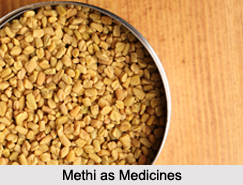 Methi, botanically known as Trigonella Foenum-gracum is a medicinal plant that is used in disease. It is an old medicinal plant. It has been commonly used as a traditional food and medicine. The plant is extensively cultivated in many parts of India. Its seeds are used as a condiment and its aromatic leaves, as a pot-herb.
Methi, botanically known as Trigonella Foenum-gracum is a medicinal plant that is used in disease. It is an old medicinal plant. It has been commonly used as a traditional food and medicine. The plant is extensively cultivated in many parts of India. Its seeds are used as a condiment and its aromatic leaves, as a pot-herb.
Health Benefits of Methi
While Methi is considered the finest herb for enhancing feminine beauty it also aids in sexual stimulation and balances blood sugar levels. Its ability to balance hormone levels aids in treating menopause. Its antioxidants slow ageing and help prevent disease. The plant has also been employed against bronchitis, fevers, sore throats, wounds, swollen glands, skin irritations, diabetes, ulcers and in the treatment of cancer. Fenugreek has been used to promote lactation and as an aphrodisiac.
Dose of Methi in Medicine
Methi or Fenugreek seeds are considered carminative, tonic and aphrodisiac. Several confections made with this article are described under the names of Methi Modaka, Svalpa Methi Modaka etc., and are recommended for use in dyspepsia with loss of appetite, in the diarrhoea of puerperal women and in rheumatism. All these preparations consist of a number of aromatic substances, one part each, and fenugreek seed equal in quantity to all the other ingredients.
The following is an illustration of Methi Modaka; take the 3 myrobalans, ginger, long pepper and black pepper, tubers of Cyperus rotundus (mustaka), nigella and cumin seeds, coriander, bark of Myrica sapida (katphala), pachak root, Rhus succedanea (Karkatasringi), ajwain, rock salt, black salt, leaves of Pinus Webbiana (talisa), flowers of Mesua ferrea (nagakesara), tejpatra, cinnamon, cardamom, nutmegs, mace, cloves, sandal wood and camphor one part each; fenugreek seeds, in quantity equal to all the above ingredients; powder them all and prepare a confection with old treacle. Its dose should be 1 to 2 drachms to be taken in the morning with clarified butter and honey.
This article is a stub. You can enrich by adding more information to it. Send your Write Up to content@indianetzone.com
Related Articles
Ayurveda
History of Ayurveda
Origin of Ayurveda
Ayurveda Medication
Elements of Ayurveda
Concepts of Ayurveda
Ancient Literature of Ayurveda
Sushruta Samhita
Use of Vegetables or Plants as Medicines




















